You want to have the best collection of authentic cards and outmatch every other collector.
But how can you tell if a Pokémon card is fake or not, and be sure you're making a good investment?
We have handled and sent thousands of Pokémon cards from Japan to customers all over the world and below we'll teach you everything you need to know in order to tell genuine cards from those that could be fake.
How To Spot Fake Pokemon Cards
Like stocks in a profitable company, a genuine Pokémon card can be worth holding on to.
Whenever possible, always examine each card that you're interested in adding to your collection in person. You'll soon get into the habit of scanning the parts of a Pokémon card that quickly giveaway whether it is fake or real.
Also Read: Rarest & Most Expensive Pokémon Cards
You can learn to identify manyt fakes with just one glance by looking at various aspects of a card. Even the most deceptive of counterfeit cards that can fool collectors at first glance can often be uncovered through more advanced testing techniques, all of which we explain in more detail below:
1. Manufacturing Method
A fake Pokémon card is not made in the same way as a genuine card.
For that reason, you'll often find more than one manufacturing oddity when looking at a fake card compared to its genuine counterpart, such as a difference in cutting methods.
Fake cards frequently look like they have been punched right out of a sheet of cardboard. The reason for this is that they often are!
Pay careful attention to the edges and borders of Pokémon cards. If you notice a series of white dots or small pieces of cardboard "fluff" clinging to the edge of the card it's time to take a closer. For those of you that have ever popped-out a coupon from another piece of cardboard, you will have a good mental image of what to look out for.
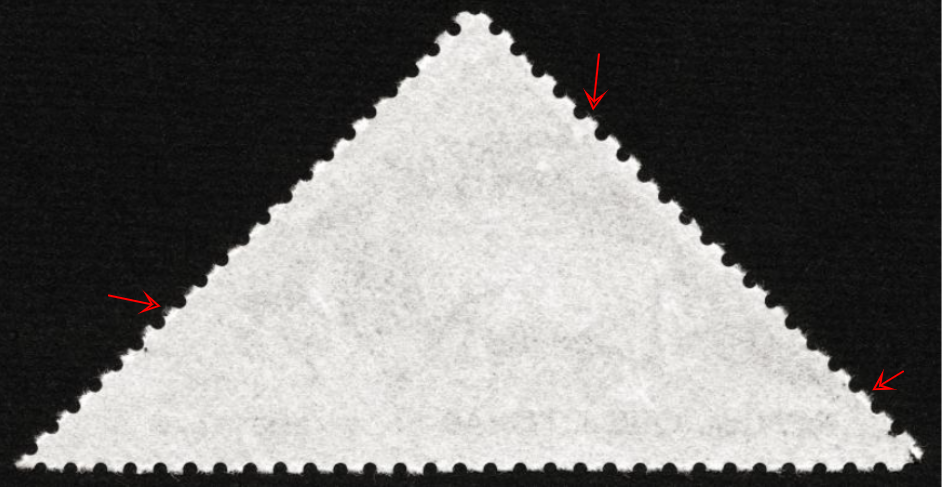
When given the opportunity to physically handle a fake Pokémon card, you may notice that the borders of the card are thicker on one side than the other. With some practice, you'll be able to pick this up by touch alone as well as by a visual inspection of the card.
If you run your fingertips along the edges of counterfeit cards they can have a different feel to the real thing. The borders on fake cards also won't usually line up with the artwork. For this reason, it's always a good idea to have a card on hand that you know is genuine so you can compare and contrast the two.
If you look at a real Pokémon card, you won't see any of these manufacturing oddities. Individual Pokémon cards are cut from large sheets and should have clean, even edges in most cases.
Also Read: How Much Are Pokémon Cards Worth?
Occasionally a "miss cut" from the official Pokémon printing factories or some other error in the cutting process has been known to occur. Therefore, checking the edges and borders of a Pokémon card is not a 100% way to verify whether it is genuine or not, but it is uncommon for these errors to occur on official Pokémon cards.
Checking the borders of Pokémon cards can be a great initial first check to see if you should further evaluate the card and use some of the other tips and methods on this list.
2. Font
Fake cards will often use different fonts to those you will find on genuine Pokémon cards. It helps to get both a fake card and a real card, preferably from the same set, and compare the two.
More often than not, you'll be able to spot the differences between the two font types immediately.
Pay attention to not only the font type being used, but also the size of the font. Fake cards will often have font sizes a little too big or too small compared to the real deal. Often this will make text appear on a different line to what appears on the official version of the card, making fakes even easier to spot.
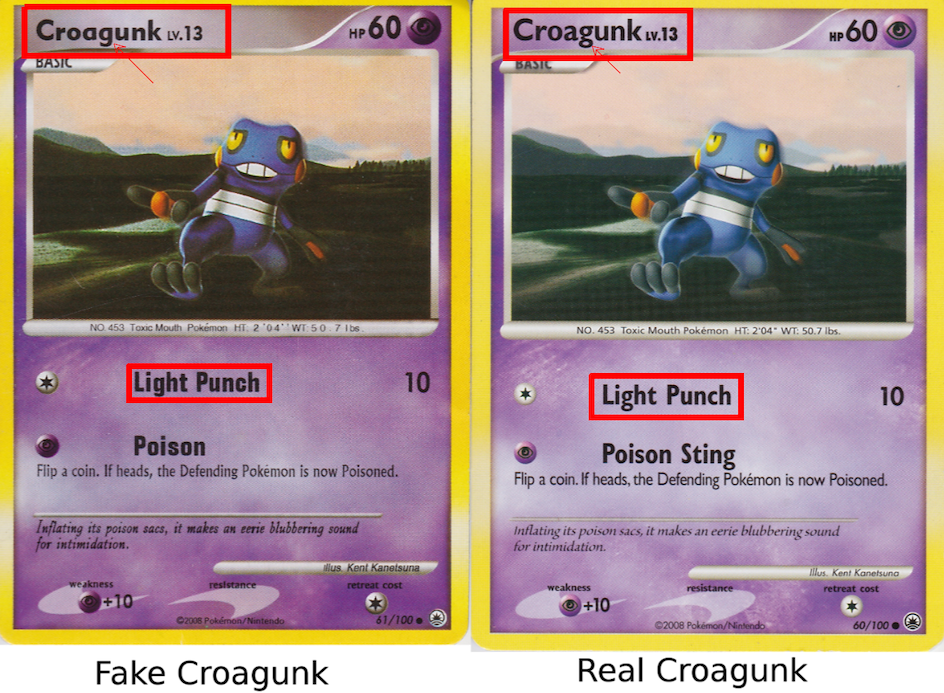
3. Spelling Mistakes
You may think this tip is an obvious one, and you would be right, but that's what makes this tip so vitally important to always keep in the back of your mind.
Because this tip is so simple, it is often overlooked and many collectors fall victim to fake Pokémon cards as they don't spend the seconds it would take to proofread the card text thoroughly.
The attack names & descriptions, Pokémon names, HP, and resistances on cards may also be spelled incorrectly, letting you know immediately that they aren't genuine. Official Pokémon cards have paid professionals to proofread them before they go to print, where that isn't the case for counterfeit cards.
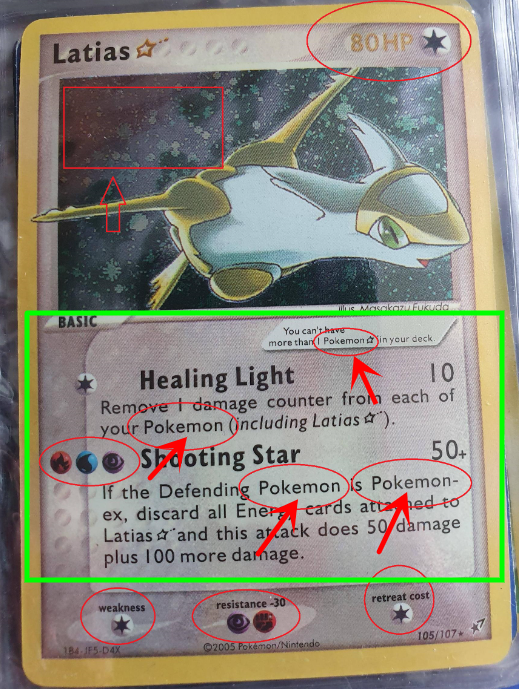
Always check the spelling of a card that you suspect is counterfeit. Cards that aren't genuine may miss the accent on the word "Pokémon" (Pokemon).
If you don't believe how something so obvious can be so easily overlooked, did you catch in this article where we spelled "Pokémon" without the accent?
You should have, the "mistake" was in the very first Section Title of the article!
Also, for English cards (which tend to be the most common counterfeit cards), it should not be written as "Pocket Monster" - it should always be written as Pokémon. Again, if it is not written as Pokémon, some texts may spill over to the next line, making it easy to spot when comparing against an authentic Pokémon card.
Buy Genuine Pokémon Cards from Japan!
4. Energy Symbols
The energy symbols on fake cards can look irregular or misplaced.
Just like with font, fake cards can have energy symbols that are sometimes too large or small. They may also be offset or look a little distorted.
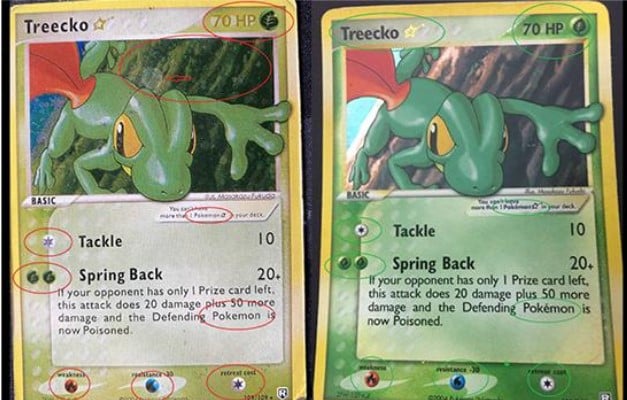
Energy symbols may even be missing in some cases, instead of being placed under the attack's description as they ought to be.
Again this may seem like an obvious giveaway, but it can be hard to remind ourselves to inspect something that may not even be there. It's best to get into the habit of confirming the presence and accuracy of energy symbols.
If the symbol looks at all unusual to you, check the rest of the card.
5. Card Back
The color of a fake Pokémon card can differ from an original in several ways.
If you turn a counterfeit Pokémon card around and look at the back, you'll frequently notice differences in art details. The color won't look the same as what you're used to, and that will be your first and most obvious sign that something isn't right.
A fake Pokémon card will be colored light blue at the back, often having a constant shade of the same blue throughout.
Genuine cards aren't just one hue of blue.
Authentic Pokémon cards combine a lighter blue with other variations of blue, so you'll see dark blue and light blue being used to form the back image of a genuine card.
When inspecting the back of a Pokémon card, having a card you know is authentic to hand is recommended. The subtleties and amount of small details present on the back art of Pokémon cards can make them quite difficult to accurately fake.
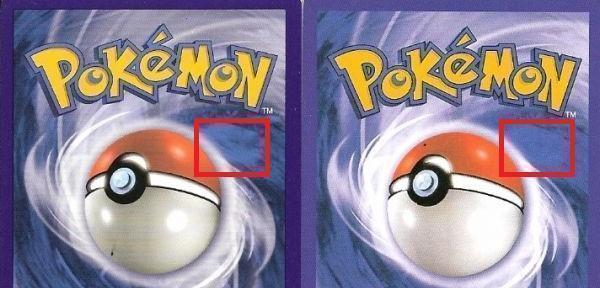
Given the opportunity to evaluate the Pokémon card in person, this is where I would recommend spending the most amount of your time assessing the card's authenticity.
If you are a serious collector, you may want to consider getting your hands on a small magnifying glass so you can zoom in on the card back and compare it with a card you know is genuine.
As is often said, "the devil is in the details."
6. Damage
Cards that are coming from the official Pokémon factory should always be in good condition. Collectors invest in their cards. While many of us collect cards purely for the love of it, the value of a Pokémon card is often heavily dependent on the condition it's in.
If you buy cards claiming to be "Pack New" and there are imperfections present, there is a chance it may not be real. It's not unheard of for producers of counterfeit Pokémon cards to slightly damage the cards they produce on purpose to make them look slightly worse or aged - in particular for cards that are from older packs.
Why?
As collectors, we're far more likely to let down our guards when buying second-hand or slightly damaged cards. We'll often accredit imperfections in these cards to simple "wear and tear" and not think to consider the irregularities are actually due to the card being counterfeit.
Make sure when buying second-hand cards you perform the appropriate checks if anything about the card raises suspicions.
Also Read: How To Buy Pokémon Cards From Japan
7. Packaging
You should take care when buying sealed Pokémon card products from questionable sources, as it's not just Pokémon singles that are at risk of potentially being counterfeit.
Cheap materials are used to make fake product boxes and you should check to see if the product comes with the plastic wrapping layer that's used on genuine boxes. Officially sealed booster boxes of Pokémon cards will be shrink-wrap in a layer of plastic that features Poké Balls on it.
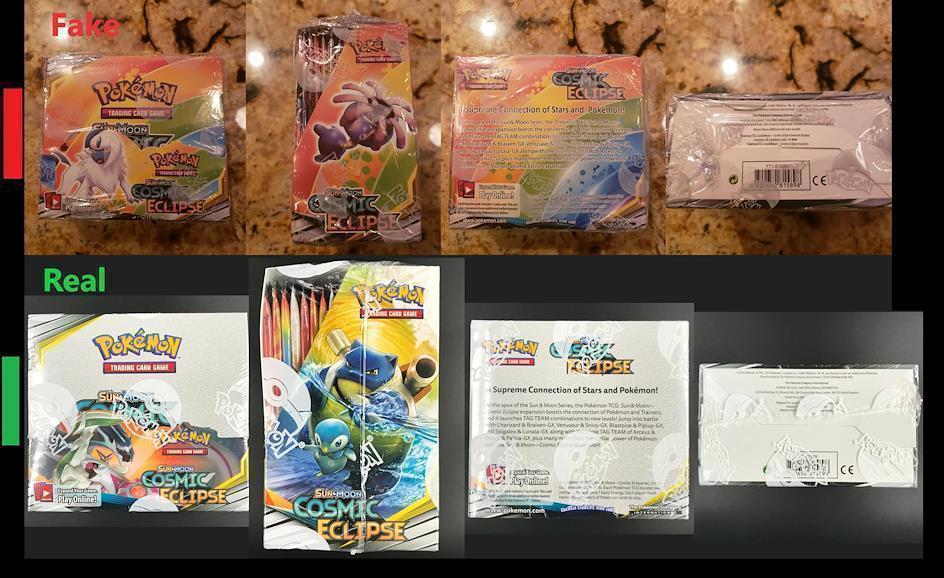
The absence of the Poké Ball shrink-wrap is not a guaranteed sign that the product is counterfeit as, for whatever reason, some sellers may choose to remove this wrapping before selling products.
However, the presence of normal shrink-wrapping warrants further investigation. There are very few reasons for sellers to remove the official shrink-wrapping to only then later replace it with standard shrink-wrap.
Buy Genuine Pokémon Packs From Japan
It's good practice before buying sealed Pokémon card products to do a quick search for the official trademark symbols that should be present on every Pokémon card packaging - something we collectors are often guilty of forgetting to add to our checklist.
Even checking this, some couterfeiters are even printing trademark symbols their on card packs too. Double check these symbols for spelling errors or compare the shape against an official card pack as an additional check.

One more simple check with sealed packs is the cutting method used on the packs themselves. Original packs are straight-cut along the top and bottom, while many fakes employ a triangle-cut, similar to what you see on many snack products.
Again, some fake Pokémon card producers have adapted to use the straight cutting style. Often though, they do not have the same sealing precision used for official Pokémon cards. This will leave larger air pockets within the sealed packs themselves.
Official Pokémon cards should not move very much, if at all inside their packs because they are sealed so precisely that there is little to no air inside. Excess card movement in a pack or visibly large air bubbles are usually a good indicator of a fake or resealed Pokémon card pack.
Also Read: How To Tell If A Pokémon Card Is 1st Edition
8. Holographic Effect
Not all Pokémon cards should have a holographic effect, and not all cards have the same holographic effect.
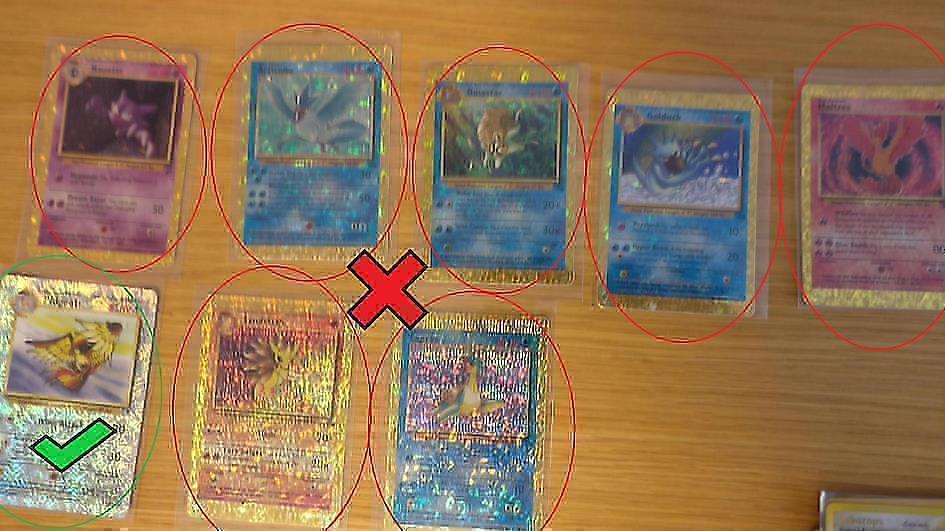
Although this tip is far more specific to the particular card you are looking to own, it is recommended you do a little bit of research into the holographic versions available for that card.
Often counterfeit manufacturers will make shiny cards with the wrong type of foiling or use a foiling that has never been officially released for that card. The opposite is also true. Occasionally, you will come across non-foil versions of cards that have only ever been officially released in foil versions.
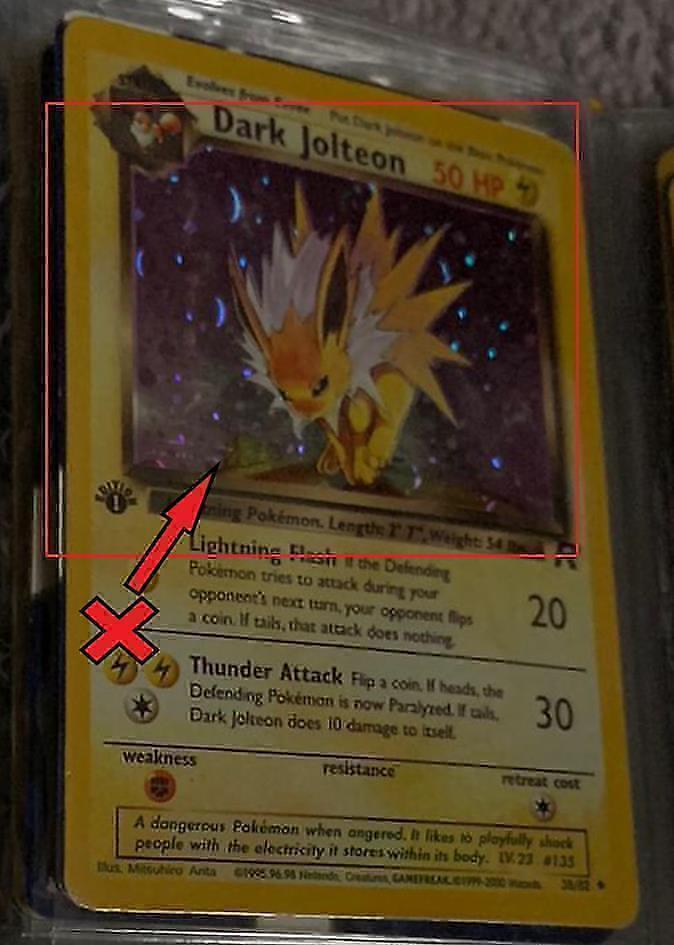
This card doesn't have an official foil version.
Needless to say, versions of cards that don't officially exist are obviously fakes. You can browse the Official Pokémon Card Database here.
NOTE: This is the Official Pokémon Trading Card Game Database and includes stats and information used for playing the game. While it is an exhaustive list of official cards used for playing the game, it does not feature:
- Trophy Pokémon Cards from Tournaments (eg. #1 Trainer Card)
- Pokémon Prize Cards for Events (eg. Pikachu Illustrator Card)
- Authentic Pokémon Cards with no Official Release (eg. "Backless" Blastoise)
- Authentic Pokémon Cards with Printing Errors (eg. Shadowless Pokémon Cards)
- Pricing Information for Individual Pokémon Cards
- Estimated Number of Pokémon Card Copies in Circulation
If you are looking for this type of information, here are a few good resources:
- Limitless TCG - Good for current packs used in Tournament Play
- PokémonCard.io - Good for browsing experimental decks for playing the TCG
- TCG Collector - Good for collectors to manage and keep track of their collections online
- Price Charting - Good for finding current market pricing for most Pokémon cards, particularly collectors items
You'll need to ensure that the card you're buying is one that has the appropriate foiling for that card in particular.
Also Read: Top 22 Rarest And Most Expensive Pokémon Cards
How To Tell If A Pokémon GX Card Is Fake?
You can tell if a Pokémon GX card is fake by using several of the tests described earlier in this article.
However, there are also some unique features that you can look out for with the GX cards.
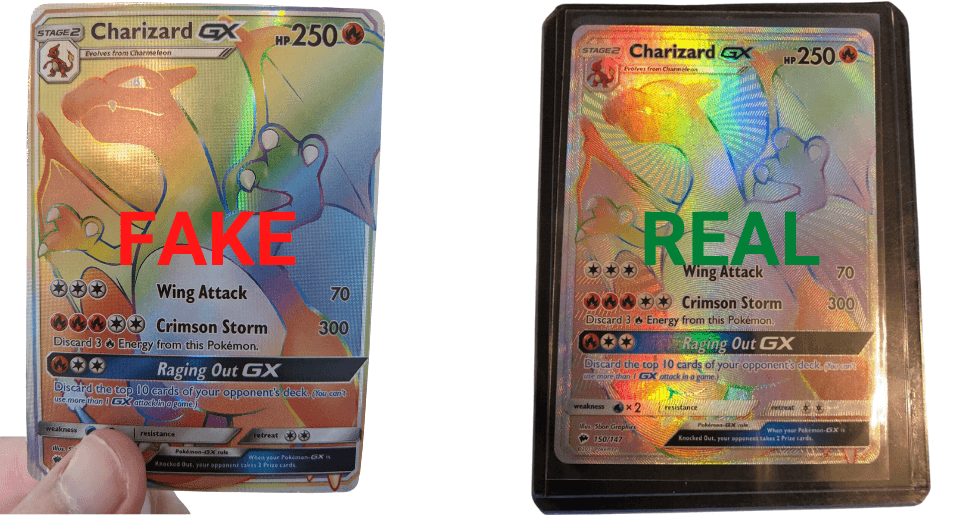
Genuine GX cards can be textured as we can see in some of the example images.
In this example, fake GX cards often have the shine from a foiling process but no texture.
Sometimes, some texture is applied but it will still not match the one on the official Pokémon card. In the example we see a grid-like texture on the fake card while the authentic card has two different spiral/ring textures.
The Rip Test
The Rip test can be considered the last resort for determining if a Pokémon card is genuine due to the fact, as the name implies, you will need to rip the card to perform this test.
Genuine Pokémon cards are made by layering semi-opaque paper and plastic in the middle of the card. Pokémon cards are designed in a way where if you rip a Pokémon card you should be able to see a black line of ink that follows the path of the rip.
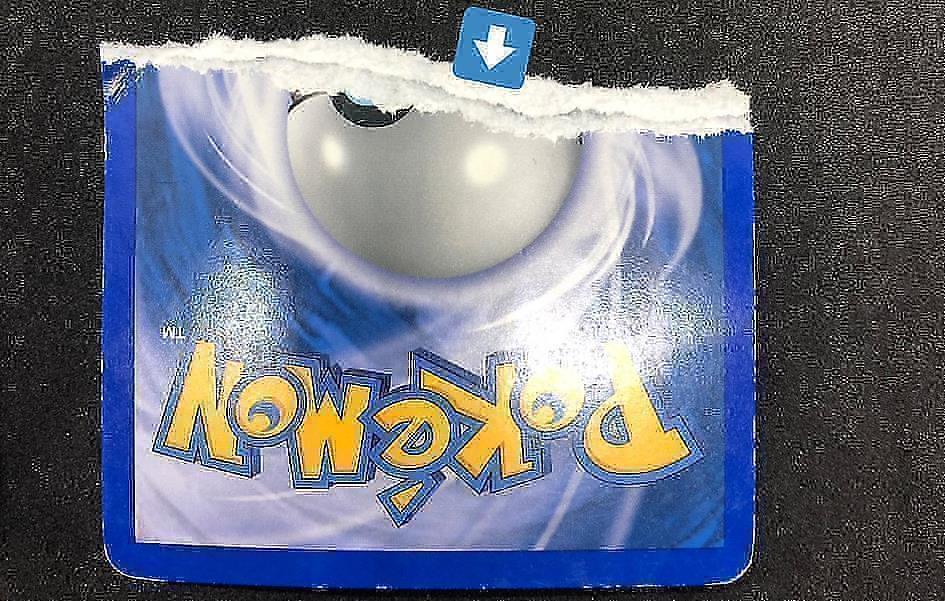
Many producers of counterfeit cards won't go through the trouble of adding this in-between layer to their fake Pokémon cards as the only way to really test for this is to rip the card, and who in the world wants to rip up their potentially genuine Pokémon cards?
This black layer present within the card is also where the streaks of black lines come from when performing the Light test on Pokémon cards.
Most counterfeit cards that have tried to replicate this black layer often do it incorrectly, if they even try to replicate it at all. If you ever perform the rip test, make sure the streak you see along the rip is black.
If the color is not black, the Pokémon card is fake. In some cases, Pokémon collectors have reported seeing blue streaks - these are also fake. However, in most cases involving counterfeit cards, you will see no streak at all.
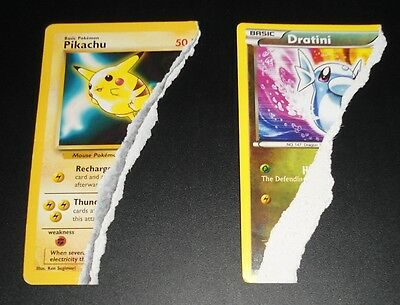
As mentioned before, the Rip Test should be used as a last resort, and only if you need to prove to a 3rd party the card is fake when all other methods have failed to draw a conclusive result.
You may also want to consider the Rip Test when buying a large number of inexpensive cards in bulk from the same seller.
Performing the Rip Test on a random card from the order may give you an indication, or peace of mind, if you have any doubts with regards to the authenticity of the collection of cards you ordered.
How To Tell If Pokémon Cards Are Resealed
Pokémon cards are sealed by machine.
If your card packs show signs of any adhesive material such as tape or a sealing process not performed by a machine, that's usually a sign that it's been resealed.
As a general rule, the authenticity of cards contained within any resealed product should be questioned.
Booster boxes are usually sealed in shrink-wrap with the logo on top. They're not wrapped in any other type of material.
How To Tell If A Japanese Pokémon Card Is Fake
The signs of a fake Japanese Pokémon card are the same as those on any other Pokémon card. However, one thing to keep in mind with regards to Japanese Pokémon cards is some Pokémon cards have different back card art.
Therefore it is important not to immediately assume that the card you have bought is fake as it may very well be genuine but with a different art compared to the English version. Likewise, don't assume the Pokémon card is genuine if it comes with strange back art just because it came from Japan, some fakes are less convincing than others...
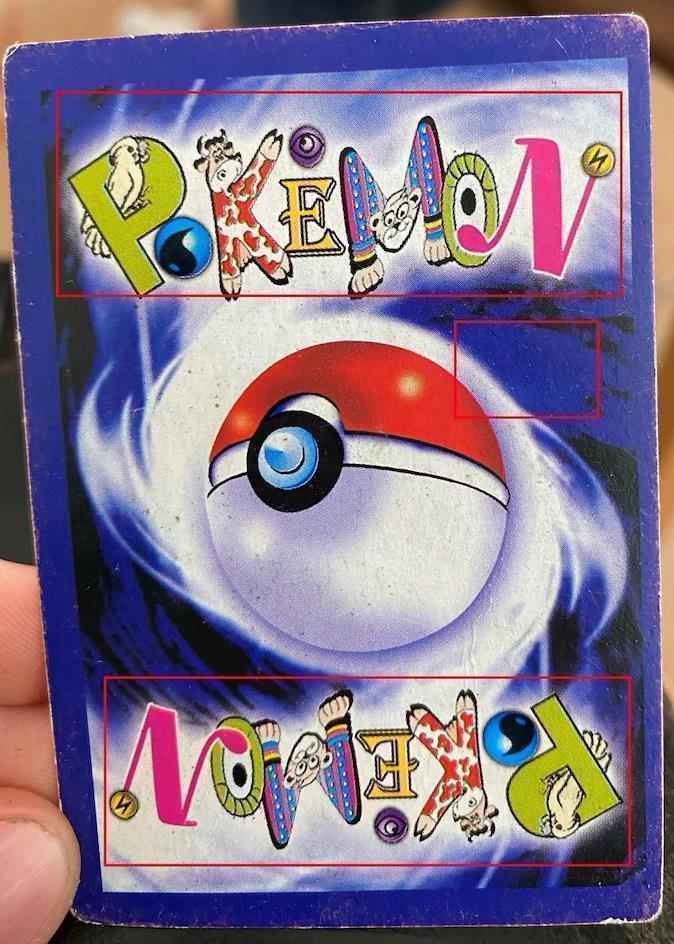
A quick search online will let you know what card back you should expect depending on the card or set of cards you are looking to buy.
All of the above tips can be applied to help identify a fake Japanese Pokémon card. However, it is important to note that the vast majority of Pokémon card collectors are English speakers.
Due to this, any large-scale manufacturing of counterfeit Pokémon cards is normally targeted towards an English speaking audience. Meaning, it is far more likely that you will encounter counterfeit English cards than you will Japanese cards.
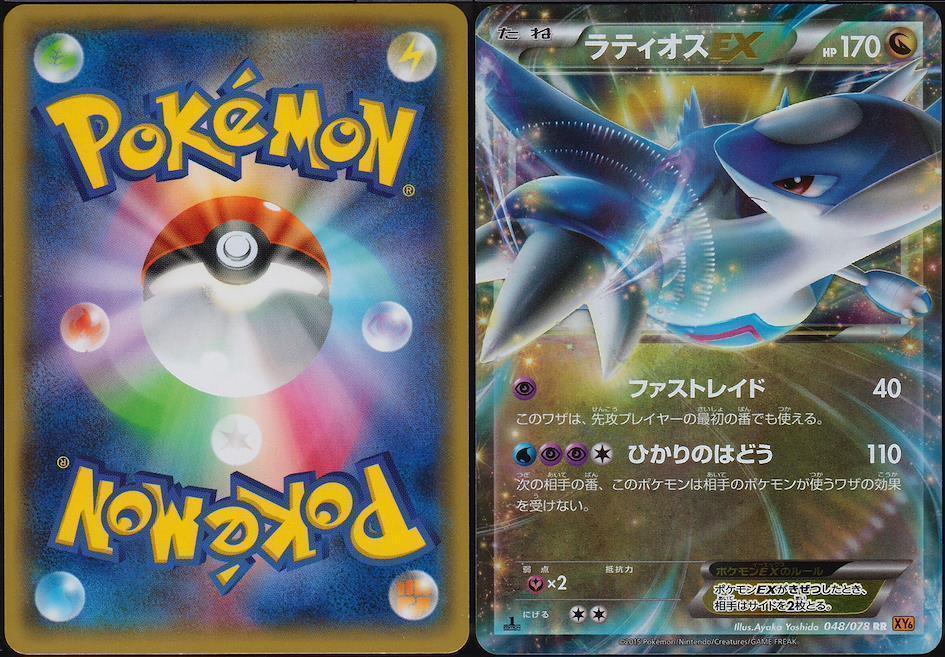
This prospect may appeal to some of you who are trying to decide whether you want to collect English or Japanese Pokémon cards as it is easier to avoid fakes cards.
With that said, we recommend that you remain vigilant even when buying Japanese Pokémon cards.
Shop at Pokémon Center Japan Today!
Suspicious Sellers
Often what can giveaway the authenticity (or lack thereof) of a Pokémon card is the integrity of the person selling the cards themselves. Particularly on auction sites where the seller may not have a brick & mortar store that they can be contacted at or held accountable, the sellers tend to be individuals.
Be particularly wary of sellers with no sale history as they likely have created the account after being discovered as a scammer on a previous account. Sellers that have a negative rating or negative reviews are also red flags.

Seller listings should always have a minimum of 2 high resolution photos of the card they are selling - one for the front and one for the back. The more photos they have, the better as this allows you to inspect the card from multiple angles.
In the case the seller does not have many photos of the Pokémon card they are selling, or if the photo they have is blurry, it could be a sign that the card is fake or that they were careless when taking the photos. In this case, you should always request better images to help you with your decision.
If the seller refuses, it is highly likely the card is fake and you should look for a different listing.
Also Read: Tips on checking JDirectItems Auction Listings
ZenMarket does not monitor all JDirectItems Auction sellers and the information providedd on the product page is only for reference. Please refer to our help page for what ZenMarket does not offer as a proxy service.
Also Read: Fake Pokémon Cards Online: Guide To Avoid Scams And Scalpers
If you do happen to purchase a fake Pokémon card from a seemingly reputable seller, please try to be understanding when raising a claim - some people are just selling cards that their kids don't use anymore and may not be aware that they are fakes.
These people are different to scammers as they are not attempting to scam you and were the victim of buying a fake card themselves. They will likely be understanding and accommodating.
False Alarms
There may be times when a genuine card has a feature that makes you wonder if it is fake.
Some genuine Pokémon cards have disproportionate borders, as Pokémon cards have been known to be inaccurately cut during the official printing process creating card borders with slightly larger edges on one side.
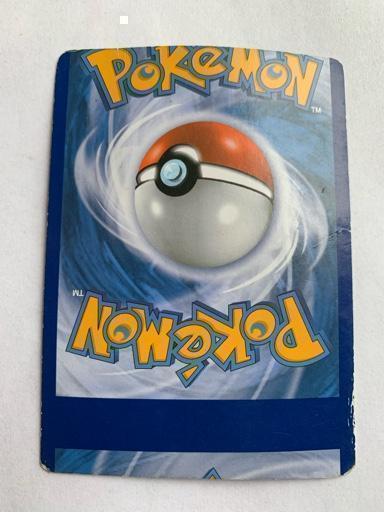
You might also see a genuine Pokémon card that has a stamped holographic larger than usual because it's part of a promotional set of cards, so it can be important to be aware of the different versions that exist for a single card.
Look out for these promotional cards and don't be too quick to assume that they're fake.
Also Read: How To Shop At Pokémon Center Japan With ZenMarket
You should also try to become familiar with some of Pokémon's existing and most common misprints. Some of the earlier Pokémon sets had a few printing errors that are well known and documented online (such as the shadowless error on first edition cards), so the information is easy to find if you are unsure about a particular card.
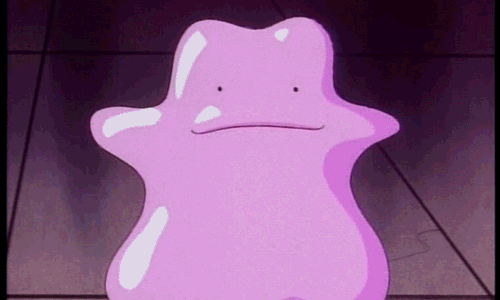
Using all the tips provided in this article you should be well equipped to know what to look out for when it comes to spotting counterfeit and fake Pokémon cards in the wild.
Unfortunately, counterfeit cards aren't going away anytime soon, but if you keep the information in this article in mind then you have nothing to fear.
The biggest real threat Pokémon card collectors face is not the fake cards themselves, but the lack of information on how to identify them. Once you are armed with the proper knowledge keeping yourself safe from adding counterfeit cards to your collection is a whole lot easier!
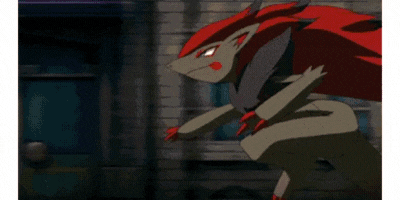
Feel free to share this article with any Pokémon card collectors you may know if you think this might help them on their journey to becoming a Pokémon trading card master.
A final word of wisdom, particularly for those looking to purchase highly valued or rare Pokémon cards - even if you are sure you are able to get an authentic Pokémon card, the condition is also very important in determining the card's value.
The small details you are able to pick up when determining authenticity of a Pokémon card may be less apparent when determining the card's condition, especially when considering the difference between good condition and pristine condition.
As such it is highly recommended that you get officially graded Pokémon cards to ensure that you are getting exactly what you are paying for.
Also Read: How To Get Pokémon Cards Graded
If you're interested in getting the latest pokémon card products directly from Japan, check out our Pokémon showcase below, where we make buying cards from Japan accessible worldwide!
Buy Pokémon Cards From Japan Now!
IMPORTANT: If you are shipping to Malaysia, there are two types of taxes that incur for trading cards.
1. Sales tax SST 10% 2. Duty tax or excise tax 10%
Please make sure that you check the customs and taxes policy for your shipping destination.